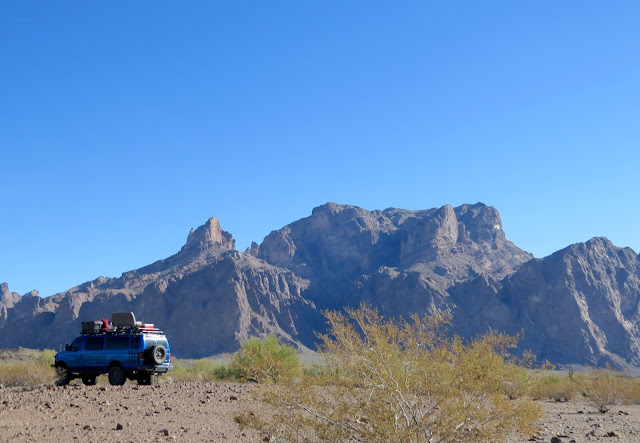Eighteen miles south of Quartzsite is Kofa National Wildlife Refuge, a 664,327 acre refuge established in 1939 for conservation of desert bighorn sheep and other native wildlife.
Sandi and I came here to hike the Palm Canyon Trail located at the end of Palm Canyon Road. The rocky, steep trail leads to a viewpoint where California Fan Palms, the only native palm species in Arizona, can be observed.
Boondocking (dry camping) is allowed in the refuge. This person has a great view with a sofa on top of his rig for looking for bighorn sheep on the mountain.
The canyon begins in the dark area ahead.
You can just see the parking lot where the road ends.
There are interpretive signs where Sandi is standing at the trailhead.
This is that view.
Looking toward Palm Canyon. The narrow canyon does not get much direct sunlight, which is just what the palm trees prefer, along with the moisture that is available. The survival of these trees is directly dependent on the micro-climate in this protected canyon.
The trail is completely in the shade, and it is noticeably cooler.
Palm Canyon is cut through a formation of rhyolite, a volcanic rock. Water, following the cracks in the rhyolite, has eroded this canyon to its present shape. The side canyons, where the palms are, are still being formed by the same process.
The rocky trail becomes steeper.
Sandi coming up the trail. You get a good view of the La Posa Plains behind her.
Airplane flying over.
We looked, but didn't see any bighorn sheep on the mountain ridges.
A palm frond...our first sign of the trees. Someone carried it here as it didn't get down here naturally.
We noticed that Saguaro Cactus grow on the canyon walls. Do you see one halfway up?
A single palm tree was spotted on the sunny side. We arrived at a lucky time. We didn't know it before we came, but found out that the palm tree grove only gets sunshine for a few minutes about 12:30 p.m. We arrived about 11:30 a.m., so timed it just about right when we got into the canyon.
The location of that single palm.
At last we could see a row of palms...still shaded in the narrow canyon ahead.
And we came to the sign pointing them out. Apparently it is possible to climb up to the trees, but it looked to me like you'd need rock-climbing equipment and knowledge to do it, so we didn't attempt.
We hung around until the sun shone on them better.
Palm trees do not produce growth rings like shade trees, so it is difficult to say how old these trees are, but people have been aware of them since before the creation of the refuge.
In 1986, forty-two trees were counted in the main grove. About half of those were adult size, with a trunk of 20 feet or more. Some smaller trees are becoming established at the base of the larger trees.
As the fronds on the California Fan Palm die, they fold downward around the trunk of the tree forming a "petticoat."
The fronds tend to self-prune, falling to the ground beneath the tree where they decompose and form a growing bed for new trees.
These are not date-bearing palms. Botanists think they are descendants of palms growing in this region during the last periods of North American glaciation.
I explored around the canyon near the viewpoint, and went to investigate this hole in a boulder.
I didn't know Sandi was taking pictures of me.
The rock is split all the way through.
High above us is what looks like a dry waterfall.
On the way back we saw several more single palms growing in tiny side canyons, now that we knew what to look for.
At first glance we thought these were new trees, but learned they are called "nolinas." They grow out of cracks or on ledges. They are much smaller than palms and don't develop a trunk.
Sandi silhouetted against the sky.
And we had this view as we made our way back to the sunshine.














































